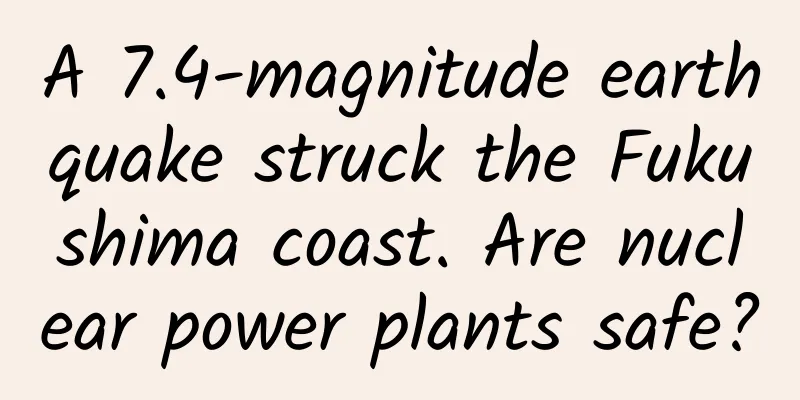A 7.4-magnitude earthquake struck the Fukushima coast. Are nuclear power plants safe?

|
Author: Gao Yali and Feng Lifei On the evening of March 16, local time, multiple earthquakes occurred in the sea near Fukushima Prefecture, Japan, with the largest magnitude reaching 7.4. After the earthquake, several nuclear power plants in Japan experienced temporary partial failures. Eleven years after the 2011 "3.11" earthquake in Japan, why did the earthquake happen again in the Fukushima waters? Are there any safety risks for the operation of nearby nuclear power plants? Will it trigger larger-scale aftershocks? China Science Daily interviewed relevant experts on this. On March 16, in Fukushima City, Fukushima Prefecture, Japan, goods in a convenience store fell to the ground due to an earthquake. Xinhua News Agency/Kyodo News This is a photo taken on March 17 in Kunimi Town, Fukushima Prefecture, Japan, showing houses collapsed due to an earthquake. Photo by Xinhua News Agency reporter Zhang Xiaoyu How big is the impact? "In fact, the epicenter of this earthquake is just a little south of the epicenter of the '3.11' earthquake in Japan. It is a re-release of accumulated energy under the same geological structure background." Xu Xiwei, director of the National Research Institute of Natural Disaster Prevention and Control of the Ministry of Emergency Management, analyzed to China Science Daily that the source of this earthquake was located near the subduction zone where the Eurasian Plate and the Pacific Plate meet. It is a tectonically active area with frequent and intense geological activities. "The '3.11' earthquake was caused by the Pacific Plate subducting westward under the Eurasian Plate. Judging from the shallow depth of the epicenter and its distance to the west, this earthquake should have been caused by secondary tectonic movement in the accretionary wedge in the upper part of the subduction zone of the plate," said Xu Xiwei. However, he said that the energy released by this largest magnitude 7.4 earthquake cannot be compared with the energy released by the 9.0 magnitude earthquake in Japan in 2011. "The energy released by a magnitude 9 earthquake is equivalent to the energy of 800 to 900 magnitude 7 earthquakes superimposed." The epicenter of the Fukushima earthquake in Japan was in the sea. The seismic waves will attenuate as they spread to the surrounding areas. In addition, Japan's housing has a high earthquake resistance standard, so the damage to land buildings in northeastern Japan will be much smaller. This is the Fukushima Daiichi Nuclear Power Plant and nuclear waste water storage tanks in Japan taken on January 8, 2021. Xinhua News Agency/Kyodo News Are nuclear power plants safe? This strong earthquake has once again brought the safety issue of the Fukushima nuclear power plant to the forefront. The huge tsunami caused by the "3.11" earthquake hit the Fukushima Daiichi Nuclear Power Plant, causing the core meltdown of units 1 to 3 of the nuclear power plant. The resulting serious nuclear leakage accident attracted global attention. At 23:00 local time on March 16, according to Tokyo Electric Power Company, fire alarms were triggered in the turbine room of Unit 5 of the Fukushima Daiichi Nuclear Power Plant and Units 2, 3, and 4 of the Fukushima Daini Nuclear Power Plant. At 4:00 the next day, the company said there were no abnormalities in the nuclear power plant. "The Fukushima nuclear power plant accident during the '3.11' earthquake was not caused by the earthquake itself, but by the tsunami that damaged the nuclear power plant's cooling system, affecting the safety of the nuclear reactor." Wang Tun, director of the Chengdu High-tech Disaster Reduction Research Institute, said, "The magnitude of this earthquake is far less than that of 11 years ago, and it is unlikely to directly cause damage to the nuclear power plant. Unless there is some additional damage on top of the invisible damage last time." Xu Xiwei said that the overall earthquake resistance standard of nuclear power plants is relatively high. From the current perspective, if there is no more major earthquakes similar to the "3.11" earthquake in the future, the impact of this earthquake on the Fukushima nuclear power plant will be limited. In response, the Nuclear Regulation Authority of Japan reported that after the earthquake, several nuclear power plants in Japan experienced brief local failures, but overall the earthquake had no obvious impact on the country's nuclear power plants. The wall of a house in Fukushima City was damaged by the earthquake (photo taken on March 16). Xinhua News Agency/Kyodo News Why was the tsunami warning lifted so quickly? After the earthquake, the Japan Meteorological Agency issued a tsunami warning to the coastal areas of Fukushima Prefecture and Miyagi Prefecture. However, as of 5:00 on March 17, all tsunami warnings were lifted. Zhao Lianda, chief forecaster of the Tsunami Warning Center of the Ministry of Natural Resources, told China Science Daily that many ocean observation stations and buoys have been deployed along the coast of Japan. After the earthquake, 30 cm and 20 cm tsunamis were observed at Ishinomaki Port and Sendai Port in Miyagi Prefecture, respectively, and 20 cm tsunamis were observed at Soma Port in Fukushima Prefecture. "Based on observation experience over the past few decades, such tsunami waves will not have much impact on the shore." Zhao Lianda said that generally a 30-centimeter-high tsunami will have an impact on water activities such as swimming and offshore aquaculture, and only tsunami waves above 1 meter will have an impact on the shore. Wang Tun explained to China Science Daily that whether an earthquake will trigger a tsunami requires certain conditions, such as how far the epicenter is from the ocean, how deep it is from the sea surface, and whether it touches the water horizontally or vertically. "If it is a horizontal trigger, which is technically called 'strike slip', it will not cause a tsunami or a large tsunami, while a vertical trigger is more likely to cause a tsunami." The 2004 Sumatra earthquake and the 2011 Tohoku earthquake both triggered huge tsunamis. Xu Xiwei analyzed that both earthquakes were of the subduction type, which caused large vertical movements of the seabed, lifted the water, and formed destructive waves similar to shock waves. "The water disturbance caused by this undersea earthquake ended after one or two hours, and monitoring results also proved that the tsunami it caused was limited, so the warning was lifted," said Xu Xiwei. According to observations from the Tsunami Warning Center of the Ministry of Natural Resources, the tsunami caused by this earthquake will not have an impact on my country's coast. "The tsunami caused by this earthquake is limited to a small area near the epicenter. Even if a major earthquake triggers a large tsunami, since the tsunami energy is distributed toward the Pacific Ocean, after passing through the Ryukyu Islands and other places, the impact of the tsunami reaching the Chinese coast will be much weakened and will not cause too much impact," said Zhao Lianda. Or trigger larger aftershocks? A few days before the March 11 earthquake, there was a 7.3-magnitude foreshock near Fukushima, Japan, and a 6.4-magnitude earthquake before that. So, will this earthquake trigger even larger aftershocks? "Generally speaking, once the crustal stress is released, earthquakes will not occur for a while, but I still need to deepen my understanding of this issue." Xu Xiwei said that although people now know that earthquakes are the result of rupture or combined rupture of different plates or fault zones, earthquake monitoring and prediction are still difficult due to insufficient understanding of the mechanism of earthquakes. The Tonga volcano erupted in January this year, which aroused public concerns about the eruption of Mount Fuji in Japan. The strong earthquake in the northeastern waters of Japan is also related to the Pacific plate. In this regard, Xu Xiwei said: "Volcanoes and earthquakes are both tectonic movements of the earth. The Pacific region is a complete plate tectonic system, and recent geological activities also reflect the spatial correlation of this tectonic movement." Is there too much geological activity recently? Shortly after the Fukushima earthquake in Japan, a 5.1-magnitude earthquake occurred in Sunan County, Gansu Province, at 8:00 on March 17, and a 5.2-magnitude earthquake occurred in Pishan County, Hotan Prefecture, Xinjiang at 21:00. Prior to that, a 6.9-magnitude earthquake occurred in Menyuan County, Qinghai Province, on January 8. Has the Earth's geological tectonic activity been too frequent recently? In this regard, Xu Xiwei said that the current activity inside the Earth is not more frequent than before. In terms of earthquake early warning, Wang Tun introduced that my country's earthquake monitoring network currently covers 2.4 million square kilometers of land area and 90% of the population in China's earthquake-prone areas. The relevant earthquake early warning technology and coverage network are leading the world. "The next step is to cover areas with lower population density and develop from single disaster early warning to multi-disaster early warning." Xu Xiwei said that at present, the deployment of relevant radio and television networks in my country's sparsely populated western regions is still relatively weak. These regions have important national projects such as the "West-East Gas Pipeline" oil and gas pipelines and the Lanzhou-Xinjiang Railway, and their safety needs to be taken seriously. He suggested that the country should quickly approve the project for the China Earthquake Science Experimental Field in Sichuan and Yunnan, break through key technologies in earthquake monitoring and prediction, and improve my country's earthquake monitoring and prediction capabilities and earthquake-resistant fortification standards. China Science Daily (2022-03-18 Page 1 of the news article, original title: "Another 7.4-magnitude earthquake hits the Fukushima area of Japan. What is the impact?") Editor | Zhao Lu Typesetting | Zhihai |
<<: How come the famous Nobel Prize was awarded to a football player?
>>: Can exercise offset the harm of staying up late?
Recommend
Nature News: What makes paralyzed people walk again? Scientists have made a new discovery
Paralysis refers to the reduction or loss of volu...
How to improve homepage conversion rate? This is what Meituan, JD.com, and Ctrip do
While I was working on this article, heavy snow w...
Cultural News: Guzheng + Fashion, what makes Chinese culture “break through the circle”?
“Young people, don’t be afraid. When you are read...
How to develop a complete user growth system architecture?
If you learn the right principles in the field of...
Survey shows that most developers have never built a mobile app
Although there are more and more mobile phones in...
Why are the giants still flocking to autonomous driving despite frequent accidents?
The birth of every cutting-edge technology is ins...
Android performance optimization - detailed explanation of memory management explosion caused by OOM crash
[[414819]] Preface In app development, images are...
Three major pitfalls in developing WeChat mini-programs
Trap 1: "Mini Program Third-Party Platform&q...
8 reasons not to upgrade to Windows 10 yet
There are only a few days left until July 29th. I...
14,000 apps were removed from the shelves at the same time, and Apple once again triggered a delisting storm!
Yesterday (May 6), the trend of apps being remove...
How to capture users from the new Internet model
The Internet model from 2012 to 2015 mainly consi...
Cui Yong: Why is China's "Nanhai I" called an unprecedented model of underwater archaeology?
The excavation of "Nanhai I" was more d...
iPhone battery drain culprit identified! Apple: I admit my mistake
Although the iPhone is not that popular now, and ...
From search rules to ranking optimization, 3 suggestions for ASO optimization
The concept of ASO has existed for a long time, b...









